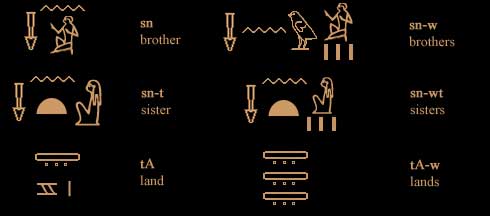All nouns are male or female in gender. Male nouns don’t have any specific suffixes to indicate their gender, while female words almost always end with a “t”. When the word is transliterated, this “t” is separated from the rest of the word (the word stem) to indicate that it is not just a phonetic component but a mark of gender. It is also important to note that the “t” is written before the determinative sign.

s – man

s-t – woman
Plural Nouns
The Egyptians employed a number of methods to indicate that a word was plural. The most common is the plural determinative (three strokes). However, it is also common to find the determinative or logogram repeated three times. The single consonant sounds “w” and “u” also indicate that a noun is plural in hieroglyphs (while in english “boy” becomes “boys”, in hieroglyphs “sn” becomes “sn-w”). However, the sign is often omitted to save space.

When you transliterate, the letter “w” or “u” should also be separated from the word stem.
Duality
The Ancient Egyptians were fascinated by the concept of duality. In hieroglyphs, this concept is indicated by the use of a double logogram or determinative, and by the addition of the single consonant sign for the sound “y” (“wy” for a male noun and “ty” for a female noun). Again, these sounds are separated from the word stem. This form was common with items which tended to come in pairs (arms, legs etc) but was also used frequently with the words “sn” (brother) and “snt” (sister).

Prepositions
Like English, Egyptian hieroglyphs often employed prepositions (words placed before the noun which link it to a verb or another noun). They were commonly used to indicate location (i.e. “in” or “under”), time (“during” or “after”), direction (i.e. “towards”) and accompaniment (i.e. “with”). Some of the most common examples are listed below.



m – in, with, from, as
r – at, towards (place)
Hn´ – with


n – for, towards (people)
in – by
Hieroglyphs Resources
- Gardiner’s sign list
- Single consonant signs
- Phonograms, Logograms and Determinatives
- Nouns and Prepositions
- Relative Forms
- Pronouns
- Word Order
- Verbs forms
- Past and Present tense
Copyright J Hill 2012